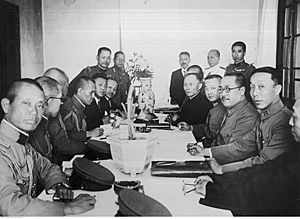Tanggu Truce facts for kids
The Tanggu Truce, also known as the Tangku Truce, was an agreement signed between China and Japan in Tanggu District, Tianjin, on May 31, 1933. This agreement officially ended the Japanese invasion of Manchuria, which had started two years earlier.
Contents
How the Truce Came About
After an event called the Mukden Incident on September 18, 1931, the Japanese Kwantung Army invaded Manchuria. By February 1932, they had taken control of the whole region. The last emperor of the Qing dynasty, Puyi, who was living in Tianjin, was asked by the Japanese to become the ruler of a new country called Manchukuo. This new country was actually controlled by the Japanese army.
In January 1933, to protect Manchukuo's southern borders, Japanese and Manchukuo forces invaded Rehe. After taking over that province by March, they pushed the remaining Chinese armies out of the northeast and beyond the Great Wall into Hebei Province.
Other countries, especially those in the West, criticized Japan's actions but did not do much to stop them. When the League of Nations (an international organization) told Japan to stop fighting, Japan simply left the League on March 27, 1933.
The Japanese army had clear orders from Emperor Hirohito not to go past the Great Wall. He wanted the fighting with China to end quickly. Because of this, the Japanese stopped their attack in May 1933.
The Talks and Agreement
On May 22, 1933, representatives from China and Japan met to discuss how to end the fighting. Japan made very strong demands. They wanted to create a demilitarized zone (an area where no soldiers or weapons were allowed). This zone would cover about one hundred kilometers south of the Great Wall, stretching from Beijing to Tianjin. The Great Wall itself would be under Japanese control.
No regular Chinese Nationalist Party (Kuomintang) soldiers were allowed in this zone. However, the Japanese were allowed to use scout planes or ground patrols to make sure the agreement was being followed. A special police unit, called the Demilitarized Zone Peace Preservation Corps, was supposed to keep order in the zone. Japan also forced China to accept Manchukuo as a real government.
There were also two secret parts of the agreement. These parts said that no anti-Japanese volunteer groups could join the Peace Preservation Corps. They also stated that any problems the Corps couldn't solve would be handled by agreement between the Japanese and Chinese governments.
China had lost many battles and a lot of land. The Chinese government, led by Chiang Kai-shek, was more focused on fighting the Chinese Communist Party than the Japanese. So, China agreed to all of Japan's demands. Also, the new demilitarized zone was mostly in the area still controlled by the Chinese military leader Zhang Xueliang.
What Happened Next
The Tanggu Truce meant that the Chinese Nationalist government unofficially accepted Manchukuo as a country. It also meant they accepted losing the Rehe province. This agreement brought a short end to the fighting between China and Japan, and for a brief time, their relationship improved.
On May 17, 1935, Japan's diplomatic office in China was upgraded. Then, on June 10, 1935, another agreement called the He-Umezu Agreement was made. The Tanggu Truce gave Chiang Kai-shek time to gather his forces and focus on fighting the Chinese Communist Party. However, this came at the cost of losing control over northern China.
Many people in China were against this truce because it was so favorable to Japan and seemed shameful for China. Even though the Truce created a neutral area, Japan still wanted more Chinese land. The Truce turned out to be only a short break before fighting started again with the beginning of the Second Sino-Japanese War in 1937.
Images for kids
See also
 In Spanish: Tregua de Tanggu para niños
In Spanish: Tregua de Tanggu para niños



